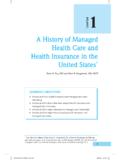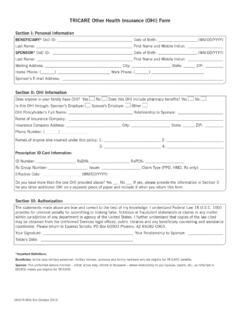Transcription of www.ravenswoodfhc.org
1 The Community health Center Movement As Congress seeks to get health spending under control and the number of people losing health coverage rises, community health centers (CHC) have become vitally important. CHCs offer the most cost effective system for delivering primary and preventive care in the country, improving the health status of our most vulnerable populations, averting and significantly reducing costly ER visits and hospitalizations. Luisa Buada, CEO Ravenswood Family health Center Today there are more than 1,200 health centers with 8,000 delivery sites providing quality, affordable health care to 20 million people in every state and territory. What are Community health Centers? Community, Migrant, and Homeless health Centers are non profit, community directed providers that remove common barriers to care by serving communities who otherwise confront financial, geographic, language, cultural and other barriers. Also known as Federally Qualified health Centers (FQHCs), they are Located in high need areas identified as having elevated poverty, higher than average infant mortality, and where few physicians practice; Open to all residents, regardless of insurance status or ability to pay; Tailor services to fit the special needs and priorities of their communities, and provide services in a linguistically and culturally appropriate manner; Offer comprehensive primary and other health care services includes services that help patients access care, such as transportation, translation, and case management; Provide high quality care to reduce inequities in health care and improve patient outcomes Affordable and cost effective, reducing costly emergency, hospital, and specialty care, and saving the health care system $24 billion a year.
2 To learn more about the Community health Center movement, read the history below. A history of Community health Centers health centers owe their existence to a remarkable turn of events in history , and to a few determined community health and civil rights activists working in low income communities during the 1960s. Millions of Americans, living in inner city neighborhoods and rural areas throughout the country suffered from deep poverty and a desperate need for health care. Among those who were determined to change those conditions was H. Jack Geiger, then a young doctor and civil rights activist. Geiger had studied in South Africa and witnessed how a pioneering community health model had wrought astonishing improvements in the health of the Zulus, a population ravaged by apartheid. In the 1960s, as President Johnson s declared War on Poverty began to ripple through America, the first proposal for the version of a community health center sprung to life at the Office of Economic Opportunity.
3 Funding was approved in 1965 for the first two neighborhood health center demonstration projects, one in Boston, Massachusetts, and the other in Mound Bayou, Mississippi. Congress also helped stake out this new direction in health care by passing several pieces of legislation. First, the Social Security Act was amended with the passage of the Kerr Mills measure (1960), which provided states with grant money for the medically indigent. Two years later, after the plight of America s migrant farm workers made national news, the Migrant health Act was signed into law to create rural clinics where migrant workers could find health care as they moved from place to place, harvesting the nation s food. But it was the passage of the landmark Economic Opportunity Act of 1964 that marked the birth of America s Community health Centers. The health center model that emerged targeted the roots of poverty by combining the resources of local communities with federal funds to establish neighborhood clinics in both rural and urban areas around America.
4 It was a formula that not only empowered communities, but also generated compelling proof that affordable and accessible health care produced compounding benefits. Studies showed that the health center model reduced health disparities, lowered infant mortality rates, and reduced chronic disease. health centers created jobs and other investments in hard pressed communities, and produced cost savings for the health care system by reducing the need for acute care at hospital emergency rooms. It is therefore the policy of the United States to eliminate the paradox of poverty in the midst of plenty in this nation by opening, to everyone, the opportunity for education and training, the opportunity to work, and the opportunity to live in decency and dignity. Preamble, 1964 Economic Opportunity Act The passage of Medicare and Medicaid in 1965 also provided much needed benefits to the elderly, disabled, and families living in poverty. In 1975, Congress permanently authorized neighborhood health centers as community and migrant health centers, and in later years added primary health care programs for residents of public housing and the homeless to the portfolio of programs.
5 The health Centers Consolidation Act of 1996 combined these authorities under Section 330 of the Public health Service Act (PHSA) to create the consolidated health centers program and what is now known as Community, Migrant, Public Housing and Homeless health Centers. The health Resources and Services Administration (HRSA), Bureau of Primary health Care (BPHC) currently administers the program, within the Department of health and Human Services (HHS). Governance health centers now constitute an integral part of the nation s health delivery system. It is the only health care system controlled in partnership with patients. Every Federally Qualified health Center (FQHC), as these centers are now known, is governed by a community board with a patient majority a patient democracy. The beauty of this system, which is unique in America s health care landscape, is that patients do not just pay for their health care, they also have a say in how their health care is delivered through their patient representatives on the center s governing board.
6 The patient majority governing board is among the five core statutory requirements that every health center must meet in order to receive federal funding. The other requirements are: Location in a federally designated medically underserved area. Have nonprofit, public, or tax exempt status. Provide comprehensive primary health care services, referrals and other services needed to facilitate access to care, such as case management, translation, and transportation. Provide services to all in their service area, regardless of ability to pay, and offer a sliding fee schedule that adjusts charges for care according to family income. Today, almost forty years after they started out as a neighborhood demonstration project, America s health centers are helping communities meet escalating health needs and address costly and devastating health problems, from prenatal and infant health development to chronic illness (like diabetes and asthma), to mental health , substance addiction, homelessness, domestic violence and HIV/AIDS.
7 health centers and their innovative programs in primary care and prevention span urban and rural communities across the nation, serving as the family doctor and health care home for more than 15 million people. Their remarkable success has earned them broad bipartisan support among federal, state, and local policy makers. What are health Centers? Community health centers are local, non profit, community owned health care providers serving low income and medically underserved communities. For nearly 40 years, the national network of health centers has provided high quality, affordable primary care and preventive services, and often provide on site dental, pharmaceutical, and mental health and substance abuse services. Also known as Federally Qualified health Centers (FQHCs), they are located in areas where care is needed but scarce, and improve access to care for millions of Americans regardless of their insurance status or ability to pay. Their costs of care rank among the lowest, and they reduce the need for more expensive in patient and specialty care, saving billions of dollars for taxpayers.
8 Currently, over 1,000 community, migrant and homeless health centers serve 3,600 urban and rural communities in every state and territory. Whom Do health Centers Serve? health centers serve as the medical home and family physician to 15 million people nationally a number that is quickly growing. health center patients are among the nation s most vulnerable populations people who even if insured would nonetheless remain isolated from traditional forms of medical care because of where they live, who they are, the language they speak, and their higher levels of complex health care needs. About half of health center patients reside in rural areas, while the other half tend to live in economically depressed inner city communities. health centers serve one in five low income children. Nearly 70% of health center patients have family incomes at or below poverty, nearly 40% of health center patients are uninsured and another 36% depend on Medicaid. Two thirds of health center patients are members of racial and ethnic minorities.
9 How Do health Centers Overcome Barriers To Care? health centers remove common barriers to care by serving communities who otherwise confront financial, geographic, language/cultural and other barriers, making them different from most private, office based physicians. They: are located in high need areas identified by the federal government as having elevated poverty, higher than average infant mortality, and where few physicians practice; are open to all residents, regardless of insurance status, and provide free or reduced cost care based on ability to pay; tailor their services to fit the special needs and priorities of their communities, and provide services in a linguistically and culturally appropriate setting. Nearly a third of all patients are best served in languages other than English; and offer services that help their patients access health care, such as transportation, translation, case management, health education, and home visitation.
10 For many patients, the health center may be the only source of health care services available. In fact, the number of uninsured patients at health centers is rapidly growing from around million in 1998 to over million today. How Do health Centers Make A Difference? Key to health centers accomplishments is patient involvement in service delivery. Governing boards the majority of which must be patients according to grant requirements manage health center operations. Board members serve as community representatives and make decisions on services provided. Active patient management of health centers assures responsiveness to local needs, and helps guarantee that health centers improve the quality of life for millions of patients in the following ways. Improve Access to Primary and Preventive Care. health centers provide preventive services to vulnerable populations that would otherwise not have access to certain services, such as immunizations, health education, mammograms, pap smears, and other screenings.




